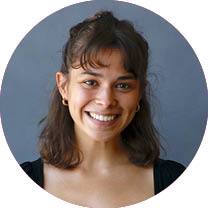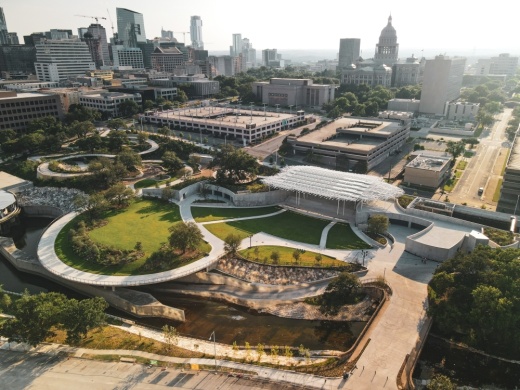Five years ago, the now demolished University Medical Center Brackenridge sat empty; plans to close the Frank Erwin Center were well in the works; and Waterloo Greenway, then called Waller Creek Conservancy, had just broken ground on the Waterloo Park project.
Since then, northeast downtown has transformed into a health-focused innovation district—complete with a state-of-the-art teaching hospital known as Dell Seton Medical Center at The University of Texas at Austin, and UT Health Austin, Dell Medical’s clinical practice—and ushered in new office space, Waterloo Park and the Moody Center.
What used to be an area that Austin City Council Member Natasha Harper-Madison has publicly described as “largely lifeless” was transformed through partnerships with the Downtown Austin Alliance, Capital City Innovation, Central Health, Ascension Seton and UT.
“Harnessing the strong tech economy, the very innovative spirit of the business community of Austin, rallying around this new medical school and this vision to transform health care delivery is the big vision of the innovation district,” said Michele Van Hyfte, vice president of urban planning for DAA.
Seeds of innovation
In 2011, then-state Sen. Kirk Watson created his “10 goals in 10 years” initiative, which included building a modern teaching hospital and a medical school.
One of the main reasons these institutions were able to take space in the area was because of the work that was happening around that time at Waterloo Greenway, said John Rigdon, director of planning and design for Waterloo Greenway Conservancy.
Before Waterloo became the plant-filled green space it is today, it was a flood-prone park that had fallen into disrepair, said Rigdon.
Initially, the city sought to address critical erosion and flooding issues along Waller Creek with funding and development of a flood-control tunnel. However, with 30 acres of downtown soon going to be out of the flood plain because of those efforts, the area became prime real estate for the development of a flourishing public space and an innovation district, Rigdon said.
Austin City Council approved the design vision for Waterloo in 2013 and raised $98 million for the project, Rigdon said.
The University of Texas Dell Medical School opened in 2014. Then in 2017, the Dell Seton Medical Center opened, which is owned and operated by Ascension Seton. The center is one of several teaching hospitals affiliated with Dell Medical School. As of June, Dell Medical School has helped to attract 415 new doctors to the Austin area, totaling approximately 10% of physicians in Travis County, according to the Travis County Medical Society—a subsidiary of the Texas Medical Association.
Of the 664 graduates from Dell Medical’s residency programs, just under half chose to practice in Central Texas. Ascension Seton and UT HealthAustin—Dell Med’s clinical practice—collaborated to add 30 new adult complex care programs and seven specialty pediatric programs to the area, including the Texas Center for Pediatric and Congenital Heart Disease, which performed the first infant heart transplant surgery in Central Texas in 2020.
Stephanie McDonald, President of Capital City Innovation—one of the five founding partners of the Innovation District—said another example of how the Innovation District has contributed to the city is the mRNA research for the COVID-19 vaccine that came out of UT Austin in 2020.
“[People] underestimate the amount of research that comes out of UT Austin and becomes commercialized and helps everyday people,” McDonald said.
Growth setbacks
In 2019, a DAA analysis showed the district would bring in 2,800 permanent jobs—including some for individuals without a college degree—and increase land value by 53%.
“And then the pandemic just squashed all that momentum,” Van Hyfte said.
The DAA has not run another economic analysis, but it has seen the strain while trying to fill the Innovation Tower—an office building built with the intention of bringing science and technology companies together to spur innovation.
Central Health—the county’s health care district serving low-income individuals—has been criticized for its role in the district by groups. Groups such as Austin Taxpayers Union, the NAACP and the League of United Latin American Citizens have alleged Central Health has lacked financial transparency.
The allegations were taken to the Travis County Commissioners Court in July, which voted to conduct a performance audit on Central Health in 2023 in an effort to better understand Central Health’s financials as it continues to expand in the Innovation District and throughout the Austin metro.
Looking ahead
Future plans for the Innovation District include Central Health finalizing plans to develop the former Brackenridge site.
When Waterloo Greenway is finished with all three phases, the park will expand from the Innovation District to Lady Bird Lake and Rainey Street.
“Ultimately, folks will be able to walk from The Butler Trail or the Mexican American Cultural Center all the way up through our park system and connect to UT at the end of the trail; all on safe accessible trails that are off the street network,” Ridgon said.
On Sept. 29, Austin City Council moved into final negotiations with developer Aspen Heights Partners for two 37-story residential towers within the district at 1215 Red River St. and 606 E. 12th St., Austin. Over 25% of the total housing space—around 900 units—will be income-restricted, which will double the number of affordable houses built downtown in the past two decades, Harper-Madison said.
She said the project, like other developments in the Innovation District, is revitalizing an area that was once a community of Black and other minority residents who were later displaced through “urban renewal,” leaving the area largely barren.
“With the new teaching hospital and the reincarnation of the Waterloo Park, we’ve been slowly revitalizing the area for a few years now, but this project promises to put that work into overdrive,” Harper-Madison said.





